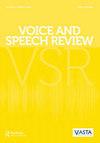Interprofessional Approaches to Acoustic Voice Analysis
IF 0.6
Q1 Arts and Humanities
引用次数: 0
Abstract
ABSTRACT When teaching voice for actors, much of the teacher’s work dwells in the realm of perceptual skills and assessment. Acting voice pedagogy often requires students to imagine physiological processes using the teacher’s descriptive imagery. Students’ progress may benefit from the incorporation of technology to teach and envision aspects of the voice that cannot be seen or are difficult to imagine. Acoustic assessment using computer software offers potential opportunities for making the intangible or imperceptible more precise and perceivable. Acoustic measures provide objective information to correlate with auditory perceptual judgments of vocal quality, discriminate between normal and disordered vocal quality, and are sufficiently stable to assess change in performance across time. For the acting voice teacher interested in exploring acoustic assessment, this paper introduces the parameters of acoustic analysis and envisions its potential uses in the studio or classroom. The teacher who explores acoustic assessment may discover new ways to discuss voice production and new tools to describe and vivify voice work using an unexpected artistic source: data. In concert with clinicians on the actor’s voice care team, the acting voice teacher versed in acoustic voice analysis may offer their students an enhanced approach to acting and speaking voice habilitation.声音分析的跨专业方法
摘要在为演员配音时,教师的大部分工作都停留在感知技能和评估领域。表演语音教学法通常要求学生使用教师的描述性意象来想象生理过程。学生的进步可能受益于将技术融入教学和想象声音中看不见或难以想象的方面。使用计算机软件进行声学评估为使无形或不可察觉的东西更加精确和可感知提供了潜在的机会。声学测量提供了客观信息,与人声质量的听觉感知判断相关联,区分正常和紊乱的人声质量,并且足够稳定,可以评估随时间的表现变化。对于有兴趣探索声学评估的表演语音教师,本文介绍了声学分析的参数,并展望了其在录音室或课堂中的潜在用途。探索声学评估的老师可能会发现讨论声音制作的新方法,以及使用意想不到的艺术来源(数据)描述和生动化声音作品的新工具。精通声学语音分析的表演语音老师与演员语音护理团队的临床医生合作,可以为学生提供一种增强表演和说话语音适应能力的方法。
本文章由计算机程序翻译,如有差异,请以英文原文为准。
求助全文
约1分钟内获得全文
求助全文
来源期刊

Voice and Speech Review
Arts and Humanities-Visual Arts and Performing Arts
CiteScore
1.00
自引率
66.70%
发文量
51
 求助内容:
求助内容: 应助结果提醒方式:
应助结果提醒方式:


